Angela came over this morning to have us babysit some luggage, while she continues her Hungarian studies in Szeged for four more weeks. We had decided to go to the Amstel Café for dinner with her and her friend Tara later this evening. Ron and I decided to try to beat the heat by getting in a movie. We settled on “Memoirs of a Geisha” since we both read the novel. I always claim that I hate seeing a movie after reading the book. It is a set-up for disappointment. Regardless of my claims, I do it. I have this morbid curiosity to see how they have destroyed what some author has created. Aside from having read the book, this movie was visually stimulating. It did not follow the book and as a story, I liked the book much better. However, the cinematography was excellent, though the sound quality was miserable. When listening to non-native English speakers speaking with thick accents, it is incomprehensible when there is any other background noise. In the opening scenes, there are children speaking. Their elocution is not the best, but a further disruption to this is when they were walking up stairs with wooden shoes. The noise made by their shoes obliterated their speech. This happened again and again with different scenes; background noises of daily events blotting out the story lines. When we let the theater, it was pouring rain with thunder and lightning; we of course, did not have umbrellas. Walking in the rain was refreshing after the blistering heat, but we aborted our plan to meet Angela and Tara at the melted cow statue and went directly to the restaurant. By the time we arrived, it had stopped raining. Dinner was all that we had come to expect from past experiences and the four of us went for a walk down to the Szoda pub and then the Four Seasons hotel to show Tara. On our way home, we stopped at a new palacsinta place and had dessert crepes. It is a 24-hour restaurant, so this will be on our list of places to return to often; they are very inexpensive.
Pin It Now!Saturday, July 29, 2006
Friday, July 28, 2006
Hot Enough to Melt a Cow
0 comments
 Though I am still fighting some stomach thing, I had to get out of the house today. Those lying meteorologists, who predicted we would have an unusually cool summer, should be struck up by their barometers over an open pit with blazing coals. I attempted to complete yesterday’s agenda today, despite the consequences of the heat.
The strategy was to begin at the Dorottya Gallery at Dorottya utca 8; it is right off of the end of the line of the M1 subway, then work my way up on the M1 to the others. Why the Dorottya Gallery is listed as a museum is beyond my comprehension other than the fact that they are somehow connected to the Ernst Museum. The description states “…a bright and spacious gallery which concentrates on media art, set design and contemporary installations.”
As I approached the street, there was a large painted covering over the building while it is being remodeled into an apartment building. I thought the gallery would be closed, but it was next door. The entire front is clear glass windows making entering unnecessary. From the street, I was able to view the entire gallery, which consisted of modern art pieces, presumably for sale. This “spacious gallery” was not much larger than my living room, but I am fortunate to have a large living room. To make sure I was not overlooking something, I did go in, realized that I was not missing a thing, and left again. Though I it eludes me what I expected from the description, what I saw did not struck any cords.
From here, I went back to the M1 subway to make my way to the Zoltán Kodály Memorial Museum. The M1 stop is conveniently Kodály körönd. What none of the web sites, Tour Inform, Talking Cities, or the museum’s own site fails to say is that the whole building is under reconstruction. On each corner, one building is numbered 1 - 4, so it is impossible to miss number 1 where the museum is located. The street directly in front of the building is barricaded to both pedestrian and auto traffic, so I could not get close enough to see if there were signs of a museum there or when the anticipated reopening date would be. With this being a washout, the next stop was the György Ráth Museum.
The György Ráth Museum is an extension of the Hopp Ferenc Museum. The admission is free and photos are not allowed, therefore no photo tickets either. There were ten employees standing around as I entered and who spread like roaches when the lights come on when they spotted me. The collection is impressive with rooms devoted to Chinese, Japanese, and Indian art that has been collected by Hopp and others. On the first floor, after going up a staircase to enter the museum, there are three good-sized rooms on either side of the entry hall with the cashier’s desk. Why a cash register and cashier are needed for the few items that are for sale is a break from reality.
There was only one fan going in the center display room, so once leaving this room, the temperature was unbearable. Everyone was solicitous in making sure I found the English explanations and there were various signs on the wall translated into English. Although I would have spent more time looking at the excellent examples of art work, they ushered me upstairs for more. As physics teaches us, heat rises, so the second floor was an oven. After ten minutes, I thought I would pass out. I was torn between leaving immediately giving the attendant the impression I was not interested in their offerings or staying to show my admiration of the fine pieces. I gave it all of ten minutes more, constantly pulling at my shirt to ventilate my overheated body, then told the man attending to me, the sole visitor, I will return in cooler weather. He pointed to the air conditioner unit and said “Kaput”. Kaput or they cannot afford the electric bill, this is a great find, not to be missed in less than boiling weather conditions.
I was going to try to fit in the Transportation Museum, but I wilted out of that option and headed for California Coffee Company for an iced coffee and a bagel sandwich. The one thing I do miss from the States are bagels. I lived on three bagels a day in California and this was the first I would have in Budapest. The iced coffee was full of flavor, though I would hardly call it a latte, but the bagel was less tasty than boiled cardboard. It was a major disappointment, but I did sit outside under an umbrella with a miniscule breeze and finished reading my latest novel.
Though I am still fighting some stomach thing, I had to get out of the house today. Those lying meteorologists, who predicted we would have an unusually cool summer, should be struck up by their barometers over an open pit with blazing coals. I attempted to complete yesterday’s agenda today, despite the consequences of the heat.
The strategy was to begin at the Dorottya Gallery at Dorottya utca 8; it is right off of the end of the line of the M1 subway, then work my way up on the M1 to the others. Why the Dorottya Gallery is listed as a museum is beyond my comprehension other than the fact that they are somehow connected to the Ernst Museum. The description states “…a bright and spacious gallery which concentrates on media art, set design and contemporary installations.”
As I approached the street, there was a large painted covering over the building while it is being remodeled into an apartment building. I thought the gallery would be closed, but it was next door. The entire front is clear glass windows making entering unnecessary. From the street, I was able to view the entire gallery, which consisted of modern art pieces, presumably for sale. This “spacious gallery” was not much larger than my living room, but I am fortunate to have a large living room. To make sure I was not overlooking something, I did go in, realized that I was not missing a thing, and left again. Though I it eludes me what I expected from the description, what I saw did not struck any cords.
From here, I went back to the M1 subway to make my way to the Zoltán Kodály Memorial Museum. The M1 stop is conveniently Kodály körönd. What none of the web sites, Tour Inform, Talking Cities, or the museum’s own site fails to say is that the whole building is under reconstruction. On each corner, one building is numbered 1 - 4, so it is impossible to miss number 1 where the museum is located. The street directly in front of the building is barricaded to both pedestrian and auto traffic, so I could not get close enough to see if there were signs of a museum there or when the anticipated reopening date would be. With this being a washout, the next stop was the György Ráth Museum.
The György Ráth Museum is an extension of the Hopp Ferenc Museum. The admission is free and photos are not allowed, therefore no photo tickets either. There were ten employees standing around as I entered and who spread like roaches when the lights come on when they spotted me. The collection is impressive with rooms devoted to Chinese, Japanese, and Indian art that has been collected by Hopp and others. On the first floor, after going up a staircase to enter the museum, there are three good-sized rooms on either side of the entry hall with the cashier’s desk. Why a cash register and cashier are needed for the few items that are for sale is a break from reality.
There was only one fan going in the center display room, so once leaving this room, the temperature was unbearable. Everyone was solicitous in making sure I found the English explanations and there were various signs on the wall translated into English. Although I would have spent more time looking at the excellent examples of art work, they ushered me upstairs for more. As physics teaches us, heat rises, so the second floor was an oven. After ten minutes, I thought I would pass out. I was torn between leaving immediately giving the attendant the impression I was not interested in their offerings or staying to show my admiration of the fine pieces. I gave it all of ten minutes more, constantly pulling at my shirt to ventilate my overheated body, then told the man attending to me, the sole visitor, I will return in cooler weather. He pointed to the air conditioner unit and said “Kaput”. Kaput or they cannot afford the electric bill, this is a great find, not to be missed in less than boiling weather conditions.
I was going to try to fit in the Transportation Museum, but I wilted out of that option and headed for California Coffee Company for an iced coffee and a bagel sandwich. The one thing I do miss from the States are bagels. I lived on three bagels a day in California and this was the first I would have in Budapest. The iced coffee was full of flavor, though I would hardly call it a latte, but the bagel was less tasty than boiled cardboard. It was a major disappointment, but I did sit outside under an umbrella with a miniscule breeze and finished reading my latest novel.
Thursday, July 27, 2006
No Start Day
0 commentsToday was meant to be a full day with four small museums planned. However, the last two days have left me feeling drained and sick to my stomach, most likely due to the heat. I have not been sleeping well, so this could be a contributing factor. I had to pull back from today’s event list since three of the museums close by 2:00 pm. Tomorrow is another day, another museum. Hopefully, the heat will not be so bad, but unlikely.
Pin It Now!Wednesday, July 26, 2006
Hungarian National Gallery
0 commentsWe were going to meet Angela Bennett, a former Fulbrighter here at our place and then go to the Hungarian National Gallery together, then on to Fortuna for lunch. However, we had a guest leaving today and he had requested that he leave his things here until 11:50 when he was to leave for his train. This set our day back a bit. Instead of going to the museum first, we wisely went to lunch first. For a very reasonable meal on Castle Hill, you cannot miss this place. Walking past Matthias Church on Fortuna, you will see the Fortuna Passage. As you enter the passage, there is a restaurant to the left, but if you by-pass that and go in the next door, there is a stairway leading upstairs. Here you will find a cafeteria-style restaurant, though the menu can be intimidating. The food is excellent and the quantities are Hungarian huge, but the prices are cheap. They are only open from 11:00 am to 2:00 pm. I had a delicious turkey in Roquefort sauce with peas and broiled potatoes, while Ron had veggie lasagna and a tomato salad all for 1,630 Huf. The portions were large; we could not finish it all. In order to enjoy the Hungarian National Gallery for me, one needs to be familiar with Hungarian artists. Entry was 1,200 for me and Ron was admitted free again due to his ‘senior’ status. We started with the special exhibit of the Hungarian Fauve artists. This is what wikipedia has to say about the Fauve movement in general: “Les Fauves (French for wild beasts) were a short-lived and loose grouping of early Modern artists whose works emphasized painterly qualities, and the use of deep color over the representational values retained by Impressionism. Fauvists simplified lines, made the subject of the painting easy to read, exaggerated perspectives and used brilliant but arbitrary colors. They also emphasized freshness and spontaneity over finish.” In the rest of the museum, there is little information in English other than the translated names of the pieces. With no knowledge of Hungarian artists, I could tell what I found interesting from those I did not; however, it would have been more pleasurable to have some background. The most enjoyment came from anything that was in an air-conditioned room. This gallery should take a page from the Museum of Fine Arts and have a guided tour of different galleries to expose non-Hungarians to Hungarian artists. Since we had guests arriving, I did have to rush home after 2 hours and Ron had a private lesson to give, so perhaps I did not give it my all. Some guests have spent four or more hours here. I will have to give it a go again in the future, though this was not my first visit.
Pin It Now!Tuesday, July 25, 2006
Budapest History and Military Museums
0 commentsIt is not unusual how one can live somewhere for a long time and not see all of the cultural venues available in their city. When I was living in Philadelphia, the only time I went to Ben Franklin’s or Betsy Ross’s house was when I had company. The Art Museum there is phenomenal, but it was only when out-of-towners came that I ventured in for another visit. When you live somewhere, there is no urgency to see everything since you know you are not time limited like you would be on a vacation. With this attitude, you sometimes never get to some of the places you should have.
The Budapest History Museum is a case in point. We have lived here for almost five years and we had never been to this museum, though one would think it would have been one of our first stops. The museum is located at the back of the castle in building “E”. Ron was able to gain free admission since he is over 65 and there were no nationality exceptions. My entrance fee was 1,200 Huf and a photo ticket would have been an additional 800 Huf, if I had bought one. Since I don’t like to buy a pig in a poke, I chose to see the museum before buying the ticket.
Budapest made the decision to create its own museum in 1887 with the first exhibition to celebrate the opening in 1984. The present location was established in 1967 housed over the remains of the Mediaeval Royal Palace. The museum covers Budapest history from prehistoric times to the beginnings of modern times.
The basement level has wandering halls where one can see the remains of the Royal Palace, gothic hall, renaissance hall, and chapel. From here you can wander out into the gardens. The ground floor houses artifacts from Budapest in the Middle Ages, the Baroque Hall, and gothic statues. On the first floor, one will find a continuation of Budapest in the Middle Ages, a bit of Budapest in modern times, though not current times, and the temporary exhibition hall is on this level. Finally, the second floor, houses the prehistoric people and various cultures settling in the area up to the Avars, a nomadic people who traveled from Eurasia, thought to be of Mongolian-Turkic stock.
This is a wonderful museum to spend a lazy half day. There was scheduled a movie in English at 1:30, but it never happened. We are not sure why. It is in Hungarian at 2:00 pm. The part that seemed disharmonious and others had mentioned this also, is that the prehistoric exhibits were on the top floor. This made the time line seem to bounce around from floor to floor without continuity. Other than this minor adjustment, this is an exceptional museum to learn the captivating history of the city. No one who is interested in the royals of the country should miss this museum. For those interested in the current history of the city, you will have to wait until I make it to the Kiscelli Museum where this collection is located. I would return here with the intent to buy a photo card. There were some shots I would have liked to have had.
 The plan upon leaving here was to visit the Telephone Museum on the other side of Castle Hill, so we ventured that way. When we found the museum, it was already 3:15 and the museum closes at 4:00 pm. In addition, the entrance is on the street behind the one that the museum is listed on in the tour guide. We thought it best to put this museum off for another time rather than rush through it.
In cultural Budapest book, I had read that if one were to look over the north rampart wall, there would be a display of old electrical streetlamps in view as the outdoor part of the Electricity Museum. We looked, but could not find it, so perhaps the book is too outdated for this. What we did come across was the Military Museum, so we went here instead.
The plan upon leaving here was to visit the Telephone Museum on the other side of Castle Hill, so we ventured that way. When we found the museum, it was already 3:15 and the museum closes at 4:00 pm. In addition, the entrance is on the street behind the one that the museum is listed on in the tour guide. We thought it best to put this museum off for another time rather than rush through it.
In cultural Budapest book, I had read that if one were to look over the north rampart wall, there would be a display of old electrical streetlamps in view as the outdoor part of the Electricity Museum. We looked, but could not find it, so perhaps the book is too outdated for this. What we did come across was the Military Museum, so we went here instead.
 The Military Museum is free entry and a photo ticket is
The Military Museum is free entry and a photo ticket is 600 Huf. Since I did not have to pay admission, I felt buying a photo ticket would be a good way to lend support to the museum. The museum is housed in what was once a municipal army barracks. It traces the history of war in Hungary through an extensive collection of war memorabilia, ranging from weapons and uniforms to coins and flags. Each conflict Hungary was involved in has its own dedicated area. There are three floors, but it was so hot in there, after viewing the exhibits on the ground and first floors, I called it quits. I could not be considered a military history buff by any stretch of the imagination, so to have progressed this far was really an expansion of my horizons.
600 Huf. Since I did not have to pay admission, I felt buying a photo ticket would be a good way to lend support to the museum. The museum is housed in what was once a municipal army barracks. It traces the history of war in Hungary through an extensive collection of war memorabilia, ranging from weapons and uniforms to coins and flags. Each conflict Hungary was involved in has its own dedicated area. There are three floors, but it was so hot in there, after viewing the exhibits on the ground and first floors, I called it quits. I could not be considered a military history buff by any stretch of the imagination, so to have progressed this far was really an expansion of my horizons.
Sunday, July 23, 2006
XPatLoop Interview
0 commentsThe publisher of XPATLOOP.com www.xpatloop.com has read my blog and asked if I would do an online interview. It was fun to answer the questions and they are posted on the site at http://www.xpatloop.com/interviews_list_detail.php?category=&id=239 for all to read. It is a great source of English happenings for
Saturday, July 22, 2006
Stained Glass Heaven
0 comments For anyone who appreciates stained glass, this is the most exquisite museum to visit. Mikas Róth had a worldwide reputation with his glass works both creating stained glass and later painting on glass. Born in 1855, he learned his art from his father who was also a stained glass master artist. Mikas took over the family studio at the early age of 19 years old.
It is said that his talents with painting on glass is what set him apart from the rest,
For anyone who appreciates stained glass, this is the most exquisite museum to visit. Mikas Róth had a worldwide reputation with his glass works both creating stained glass and later painting on glass. Born in 1855, he learned his art from his father who was also a stained glass master artist. Mikas took over the family studio at the early age of 19 years old.
It is said that his talents with painting on glass is what set him apart from the rest, creating a reputation for greatness. He also created mosaics, which are equally extraordinary. His works are still part of buildings in Mexico, Serbia, and Oslo just to name a few.
creating a reputation for greatness. He also created mosaics, which are equally extraordinary. His works are still part of buildings in Mexico, Serbia, and Oslo just to name a few.
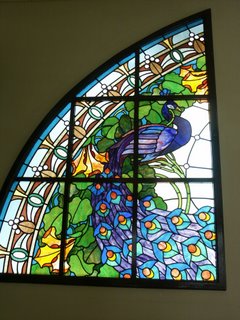 His former home is the site of the museum located at Nefelejcs utca 26 in District VII. The entrance fee was 500 Huf and the photo ticket was 2,000 Huf. If you have any appreciation for stained glass or mosaics, this is not a museum to by-pass a photo ticket.
His former home is the site of the museum located at Nefelejcs utca 26 in District VII. The entrance fee was 500 Huf and the photo ticket was 2,000 Huf. If you have any appreciation for stained glass or mosaics, this is not a museum to by-pass a photo ticket.
Friday, July 21, 2006
A Full Day
0 comments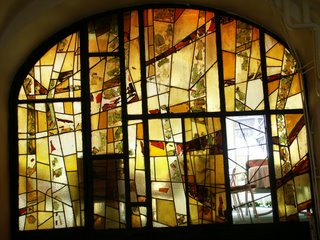 The plan for today was to visit the Museum of Commerce and Catering and then on to the Museum of Music History, but it turned out to be more fulfilling a day than expected.
After getting to Castle Hill, I had an idea where Fortuna utca was located, but as I walked by a restaurant, I was stopped in my tracks by a fetching piece of stained glass. My habit is always to brake for any stained glass; it is one of my favorite forms of art. As I was admiring it, a waiter from the restaurant approached to pull me in, but I sideswiped him by asking for directions to the museum. Knowing full well I was across the street from where I wanted to go, I was able to distract his attention from making me a patron. I was tempted to ask him to close the one window; it was ruining the shot, but I thought it might entail having a meal in gratitude.
In his stumbling English, I understood him to say that the museum was closed and due to be moved to the Pest side later in the year. With this information, I thanked him and went one block further to the Museum of Music History on Táncsics Mihály utca 7 in district 1 on Castle Hill. This is where things became a bit confusing. According to their website, the museum is located in the “magnificent Baroque surroundings of the Erdődy Palace”. The website also states it is closed, but I needed to see for myself. It was indeed open and the man greeting me in the courtyard informed me of the 1,000 Huf entrance fee. He also explained that they only had the special exhibit of Bartók Béla’s work. The Bartók Béla Memorial Museum is also listed as being closed, so this may be a combined exhibit during a renovation.
Having the nickname of “Dr. Think out of the box”, I decided that I needed to practice
The plan for today was to visit the Museum of Commerce and Catering and then on to the Museum of Music History, but it turned out to be more fulfilling a day than expected.
After getting to Castle Hill, I had an idea where Fortuna utca was located, but as I walked by a restaurant, I was stopped in my tracks by a fetching piece of stained glass. My habit is always to brake for any stained glass; it is one of my favorite forms of art. As I was admiring it, a waiter from the restaurant approached to pull me in, but I sideswiped him by asking for directions to the museum. Knowing full well I was across the street from where I wanted to go, I was able to distract his attention from making me a patron. I was tempted to ask him to close the one window; it was ruining the shot, but I thought it might entail having a meal in gratitude.
In his stumbling English, I understood him to say that the museum was closed and due to be moved to the Pest side later in the year. With this information, I thanked him and went one block further to the Museum of Music History on Táncsics Mihály utca 7 in district 1 on Castle Hill. This is where things became a bit confusing. According to their website, the museum is located in the “magnificent Baroque surroundings of the Erdődy Palace”. The website also states it is closed, but I needed to see for myself. It was indeed open and the man greeting me in the courtyard informed me of the 1,000 Huf entrance fee. He also explained that they only had the special exhibit of Bartók Béla’s work. The Bartók Béla Memorial Museum is also listed as being closed, so this may be a combined exhibit during a renovation.
Having the nickname of “Dr. Think out of the box”, I decided that I needed to practice what I preach so very often to students and not allow my preconceived notions of classical music put me off from this museum.
This one elephantine room was filled with glass covered display cases documenting the life and work of the composer/musician. What was immensely interesting were the letter displayed that he had written in English to friends back in Budapest while he was in NYC. There was also a biography written by his son, also in English, opened and easily readable.
I had no idea, this man was in the US until his death. He had been offered a position at Columbia University and then the position was given away to another. He had written in his letter to the friend that he used his time translating Serbio-Croatian Folk songs into English, which turned out to be the highlight of his time in the U.S. Sad commentary for someone of such talents.
At the far end of the room was a sole computer monitor where I sat and watched a DVD of the man and his life’s work in English. It was unconscionable, in this day and age that the narrator sounded like he had a mouthful of peanuts he had not started to chew. There were silent movie clips of Bartók attending concerts, at work composing and so forth. There were many other tidbits of his life that were readable and a dependency of poor narration was avoidable.
Some of the poster photos on the wall were subtitled in English as well as most of the displays in the glass cases. The addition of a printout given to me by the attendant made it possible to understand all that was on view. Walking in thinking this would be a whizz through visit I surprised myself by spending an hour and a half here.
what I preach so very often to students and not allow my preconceived notions of classical music put me off from this museum.
This one elephantine room was filled with glass covered display cases documenting the life and work of the composer/musician. What was immensely interesting were the letter displayed that he had written in English to friends back in Budapest while he was in NYC. There was also a biography written by his son, also in English, opened and easily readable.
I had no idea, this man was in the US until his death. He had been offered a position at Columbia University and then the position was given away to another. He had written in his letter to the friend that he used his time translating Serbio-Croatian Folk songs into English, which turned out to be the highlight of his time in the U.S. Sad commentary for someone of such talents.
At the far end of the room was a sole computer monitor where I sat and watched a DVD of the man and his life’s work in English. It was unconscionable, in this day and age that the narrator sounded like he had a mouthful of peanuts he had not started to chew. There were silent movie clips of Bartók attending concerts, at work composing and so forth. There were many other tidbits of his life that were readable and a dependency of poor narration was avoidable.
Some of the poster photos on the wall were subtitled in English as well as most of the displays in the glass cases. The addition of a printout given to me by the attendant made it possible to understand all that was on view. Walking in thinking this would be a whizz through visit I surprised myself by spending an hour and a half here.
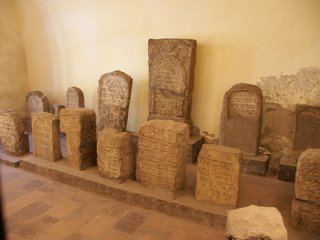 When I left this building, I started to walk around the block to see the site of the Museum of Commerce and Catering for myself to verify the information given by the solicitous waiter. What I found along the way was the Medieval Jewish Prayer House at Táncsics Mihály u. 26. It was on my list, so there was no time like the present to visit.
As in many parts of Europe, the Jews have had a difficult history in Hungary. Some of the early Kings allowed them high positions of rank, while others exiled them from the country. This prayer house is a tiny Sephardic synagogue, which was only discovered in the 1960s. It dates back to 1364, when the Jews were allowed to return to Hungary after having been exiled by King Lajos.
Under the sign of the museum, there are buzzers for other apartments in the building with the word for ‘Private’ above as a reminder that the building is occupied by residents for the most part. The entryway has a gated area to the left where headstones are on display, all with writing in Hebrew. One stone dates back to the 3rd century A.D.
In the late 17th century, the Turks who occupied the territory massacred the Jews of this area. The Habsburgs defeated the Turks and the synagogue was turned into an apartment. Nearby a larger synagogue was discovered, which dates back to 1461. The only remains of the larger synagogue is a rosette keystone and three stone columns which were originally 10 meters high. These four things are on display in this tiny synagogue.
When I entered and paid my fee of 400 Huf, I was disappointed at the size of the place. I could have viewed the entire place from the doorway. The caretaker asked me in Hungarian if I spoke Hungarian and I replied in Hungarian that I did not. He must have thought I was being modest, as he continued his monologue in Hungarian. When I said in Hungarian that I did not understand, he handed me a printout in English to read and told me to have a seat.
After finishing my reading assignment, I was looking at the walls when he came to my side and in near perfect English, gave me the history of the building. His pride in working there was evident; though he assured me he was not Jewish himself. He pointed out the three remaining columns of the larger synagogue that was nearby, which was fortunate as I would have missed them completely had he not done so. He escorted me to the gravestones and informed me that those who could speak Hebrew were able to read the inscriptions. I was taken with some of the headstones being covered in writing. As I left, I felt a bit lighter having seen this spiritual place and felt it was 400 Huf well spent.
As I was strolling back to the bus, I passed the Golden Eagle
When I left this building, I started to walk around the block to see the site of the Museum of Commerce and Catering for myself to verify the information given by the solicitous waiter. What I found along the way was the Medieval Jewish Prayer House at Táncsics Mihály u. 26. It was on my list, so there was no time like the present to visit.
As in many parts of Europe, the Jews have had a difficult history in Hungary. Some of the early Kings allowed them high positions of rank, while others exiled them from the country. This prayer house is a tiny Sephardic synagogue, which was only discovered in the 1960s. It dates back to 1364, when the Jews were allowed to return to Hungary after having been exiled by King Lajos.
Under the sign of the museum, there are buzzers for other apartments in the building with the word for ‘Private’ above as a reminder that the building is occupied by residents for the most part. The entryway has a gated area to the left where headstones are on display, all with writing in Hebrew. One stone dates back to the 3rd century A.D.
In the late 17th century, the Turks who occupied the territory massacred the Jews of this area. The Habsburgs defeated the Turks and the synagogue was turned into an apartment. Nearby a larger synagogue was discovered, which dates back to 1461. The only remains of the larger synagogue is a rosette keystone and three stone columns which were originally 10 meters high. These four things are on display in this tiny synagogue.
When I entered and paid my fee of 400 Huf, I was disappointed at the size of the place. I could have viewed the entire place from the doorway. The caretaker asked me in Hungarian if I spoke Hungarian and I replied in Hungarian that I did not. He must have thought I was being modest, as he continued his monologue in Hungarian. When I said in Hungarian that I did not understand, he handed me a printout in English to read and told me to have a seat.
After finishing my reading assignment, I was looking at the walls when he came to my side and in near perfect English, gave me the history of the building. His pride in working there was evident; though he assured me he was not Jewish himself. He pointed out the three remaining columns of the larger synagogue that was nearby, which was fortunate as I would have missed them completely had he not done so. He escorted me to the gravestones and informed me that those who could speak Hebrew were able to read the inscriptions. I was taken with some of the headstones being covered in writing. As I left, I felt a bit lighter having seen this spiritual place and felt it was 400 Huf well spent.
As I was strolling back to the bus, I passed the Golden Eagle Pharmacy Museum housed at Tárnok u. 18. This was on my list of museums to visit also, so I decided to stop in while I was here. The entrance is free, a photo ticket is 300 Huf, and a guided tour is available on request, though I did not hear the cost of this.
Being the sole visitor, I was the center of attention of the three workers staffing the place. Again, I had the same language experience as the synagogue. They thought my three-year-old level of Hungarian was a sign of comprehension and therefore they chatted on. When they realized I did not understand 90% of what they were saying, I was left to my own devices. The first room is mostly apothecary ware of historical value in the early days of pharmaceutical history. Most containers held herbs and not prescriptions. Having a medical background, I was fascinated by it. I could not help that think this would be of interest to any ceramicist also.
Pharmacy Museum housed at Tárnok u. 18. This was on my list of museums to visit also, so I decided to stop in while I was here. The entrance is free, a photo ticket is 300 Huf, and a guided tour is available on request, though I did not hear the cost of this.
Being the sole visitor, I was the center of attention of the three workers staffing the place. Again, I had the same language experience as the synagogue. They thought my three-year-old level of Hungarian was a sign of comprehension and therefore they chatted on. When they realized I did not understand 90% of what they were saying, I was left to my own devices. The first room is mostly apothecary ware of historical value in the early days of pharmaceutical history. Most containers held herbs and not prescriptions. Having a medical background, I was fascinated by it. I could not help that think this would be of interest to any ceramicist also.
 As I approached the second room, there is a third room to the right that is roped off. There were many strange and unusual things in there including a crocodile hanging from the ceiling. The English-speaking staff woman followed me in and started telling me the history of the museum. It is owned by Semmelweiss Medical University. This was originally an alchemist’s workshop and continued to be so until Maria Teresa declared alchemy illegal. The roped off room still housed the original alchemist’s supplies. As she continued speaking, my mind wandered wondering if I was being seduced into paying for a guided tour. As a compromise, I bought two postcards. This is definitely worth a visit, especially for any medicos.
As I approached the second room, there is a third room to the right that is roped off. There were many strange and unusual things in there including a crocodile hanging from the ceiling. The English-speaking staff woman followed me in and started telling me the history of the museum. It is owned by Semmelweiss Medical University. This was originally an alchemist’s workshop and continued to be so until Maria Teresa declared alchemy illegal. The roped off room still housed the original alchemist’s supplies. As she continued speaking, my mind wandered wondering if I was being seduced into paying for a guided tour. As a compromise, I bought two postcards. This is definitely worth a visit, especially for any medicos.
Thursday, July 20, 2006
Today was a late start
0 comments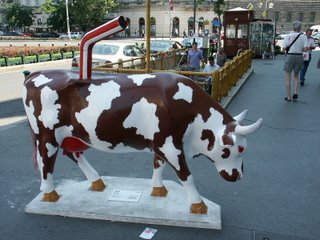 Ever wonder where chocolate milk comes from?
Ever wonder where chocolate milk comes from?
Today was a late starter day, which would have insured some student deciding for join me, but not find me where I should be. It was not until 11:30 am that Ron and I arrived at the Ferenc Liszt Memorial Museum. It is located in the VI district at Vőrősmarty utca 35. This is one stop beyond Oktogon on the M1 metro going in the direction of Heroes Square. Alas, no students in sight, so all of my excuses for being late were safely tucked away for use on another occasion. The timing for this museum was excellent. In two days, they will be closed until September 2nd for renovations.
Entrance fees were 400 Huf each and if I had sported for one, a photography ticket was an additional 750 Huf. Taking into consideration the few bucks here and there that this adventure is costing, I am becoming more frugal with making the decision to buy photography tickets.
I get lots of jeers when I share that I am not a music buff, especially not classical music, so visiting this museum was stretching my envelope. I have to admit that I did learn something tidbit of trivia. I had heard that Liszt was Austrian, but since he had spent so much time here in Hungary, the Hungarian claimed him. The truth is that he was born in Hungary, but in 1920, that village became part of Austria. Another mystery solved.
Liszt had three residences: one in Austria, one here in Budapest, and another in Italy. He spent three months of the year here and established the music academy where he presided as President until his death. The museum is his residence in Budapest. It is small considering he had a wife and three children, gave music lessons in one room, and worked here.
One walks into a hallway, now the cashier’s desk, but which is decorated with paintings and busts. Directly ahead is a small room that is filled with a piano. The laminated handout gives some information about who is pictured in the photos and other décor in the room. It is not explicit enough to be of interest. All of the signs on the walls are in Hungarian and German, but not English.
To the right of this room is a large room with various piano type instruments, but not full pianos. These were gifts to Liszt from various people.
The room to the left of the center is a large room with furniture, another piano, more décor from Liszt’s life and work. What I found most impressive was a silver music stand on the piano with the bust of famous musicians who predated Liszt. The artwork was splendid with little musical instruments on either side gracing the stand.
If one was a Liszt aficionado, this would be necessary to see museum, but for those like me, it was interesting, but there will never be a need to return.
The next stop was the Stamp Museum, which is housed at Hársfa utca 47 in the VII district. Web site tourist directions showed this as being close to the M1 metro at the Vőrősmarty utca stop also, but it is actually closer to the 4 or 6 tram stop at Wesselényi. The only other stamp museum I had ever been to was in Philadelphia back when I helped Ben Franklin put together his collection for display. It was my expectation to see a few dozen glass topped display cases with collections of stamps in them. Was I in for a shock!
After paying my insignificant entrance fee of 200 Huf and my disappointing discovery that no photographs were allowed at all, I ventured up the stairs within a beautifully tiled staircase. Walking into a lobby, the entrance is blocked by glass doors. I became the focus of attention for the four attendants working. When they questioned my language, I was provided with a sheet of English highlights to the collection.
Even with the English, I was a bit confused as to where to begin, but the ever ready woman was thrilled to assist. Along three long walls, the collection is broken into ‘blocks’. Each block is number. Within each block are thin drawers that are vertical, not horizontal. She instructed me as to how to pull out the drawer completely so it would rest on its back corner. Within each drawer were three pages of stamps on either side. Each page artistically placed to perfection on graph paper, allowed each stamp or sheet of stamps to tell their story without interruption.
When I pulled the first drawer out myself, I did not pull it out completely. I had this mental image of pulling it out of the wall. The lovely lady noticed and came to reassure me with hand gestures, that I could indeed pull it out fully to see all three pages. To the right or left of each block there is a ‘Table of Contents’ of each drawer that includes the country and the years the stamps were issued. There are hundreds of drawers dedicated to Hungarian stamps from the very first stamps up to 1998. The second and third walls have stamps from all over the world. One of the highlights were stamps from Gabon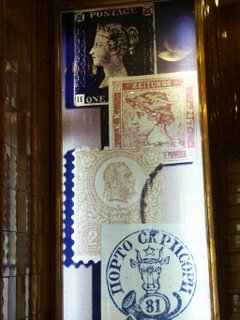 where they are coins. Others are irregular shapes, all of them masterpieces in miniature. The world’s largest stamp issued came from, of course, the U.S.
where they are coins. Others are irregular shapes, all of them masterpieces in miniature. The world’s largest stamp issued came from, of course, the U.S.
The woman went into a little room and then called me in. There is a special exhibit of stamps that have to be viewed with a large powered magnifying glass and special lighting. She set the machine to English and then left drawing the curtain. I had to manually move the magnifying glass as the narration spoke looking at the highlights of the stamps as she spoke.
When I emerged from the little room, the woman had pulled the drawers of the other highlights on the list. I thought perhaps that I was keeping them from closing, so I started to rush through at that point. In addition, there are many glass displays with other stamp memorabilia, but only in Hungarian. Feeling a bit rushed, though having been there about two hours already, I was ready to call it quits for the day. For 200 Huf, I could certainly return another time, though not taking photos did squelch my enjoyment a tad. Having some remembrances of many of these masterpieces of artwork other than my memory would have been spectacular.
The cashier must have realized my disappointment in not being able to take pictures. He allowed me to photograph the basically unadorned lobby. This was my only shot.
Posted by
Anonymous
at
5:12 PM
![]()
![]()
Labels: Austria, Budapest, Classical music, English language, German language, Hungary, Photography, United States
Wednesday, July 19, 2006
On a Sweltering Day
0 comments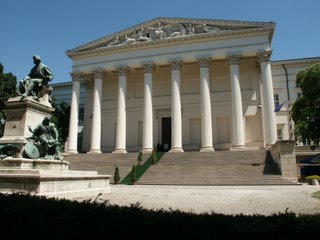 I made a second list of all of the museums in Budapest after finding a list from the tourist office that had some I did not have on the original list found on the net. It is difficult to believe just how many museums there are, though some are tiny enough to fit into our living room. Thankfully so or this project would take more than my summer.
I made a second list of all of the museums in Budapest after finding a list from the tourist office that had some I did not have on the original list found on the net. It is difficult to believe just how many museums there are, though some are tiny enough to fit into our living room. Thankfully so or this project would take more than my summer.
I sent out the list for the next week to the students; however, presumably, most are finally enjoying their summer vacation and this resembles school to them, so I do not expect great turnouts. Actually, if anyone shows, I will be surprised.
Today, I ventured to the Hungarian National Museum located in district VIII at Múzeum korut. Website: www.hnm.hu . It looks like a gloriously Greek inspired structure with tremendous columns built to the design of Mihály Pollack between 1837 and 1847. It was recently renovated and shines in splendor. The museum's area covers over 8000 square meters making it the largest in Hungary. Best of all, the admission is free! The got’cha is that a photo ticket is a whopping 3,000 Huf and 5,000 for video. Holy Hungarian, that is a blow to the wallet if you are a died in the wool camera buff. I slapped down the money, then thought I could do a whole lot more with that $13.50 (at today’s exchange), so I snatched it back confusing the cashier.
www.hnm.hu . It looks like a gloriously Greek inspired structure with tremendous columns built to the design of Mihály Pollack between 1837 and 1847. It was recently renovated and shines in splendor. The museum's area covers over 8000 square meters making it the largest in Hungary. Best of all, the admission is free! The got’cha is that a photo ticket is a whopping 3,000 Huf and 5,000 for video. Holy Hungarian, that is a blow to the wallet if you are a died in the wool camera buff. I slapped down the money, then thought I could do a whole lot more with that $13.50 (at today’s exchange), so I snatched it back confusing the cashier.
I have been to this museum twice before. The first time was 1998 and the second time was 2003, so I felt ‘due’ again. There are signs that the coat check is mandatory. They need to extend the definition since you are not allowed to take in a purse, back pack, shoulder bag or anything with you. It all must be checked or the guard will tackle you to the ground, scream while he is doing it, and everyone’s eyes will be on you. I keep a little padlock on my shoulder bag for such occasions and can lock my wallet in the compartment is lives in. If the lock is tampered with, it is an immediate alert as to whom the suspect happens to be. Perhaps it is living here that has had its effect, but I appreciated this museum much more today than in the past.
Each room is a period in Hungarian history, but the difference with this visit is that there is an English translation. The one problem that I encountered was the heat. A half hour into the exhibits, I started feeling sick and sweaty. If I did not sit down every 15 minutes, I know I would have been on the floor. It is beyond me how the employees can work there wearing uniforms. It was ungodly.
On that note, the second museum for the day was the Bible Museum in district IX. Ráday U. 28, Open: 10am-6pm daily except Mondays. On a side note, Budapest is
IX. Ráday U. 28, Open: 10am-6pm daily except Mondays. On a side note, Budapest is 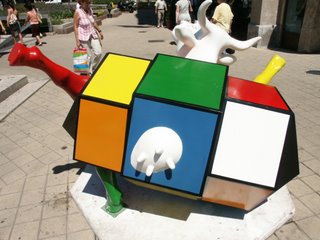 doing the “Cow Parade” that originated in Switzerland years ago. This is the first year here. There are some clever ones and some really mundane examples.
doing the “Cow Parade” that originated in Switzerland years ago. This is the first year here. There are some clever ones and some really mundane examples.
This one is rather interesting given that it was a Hungarian who invented the Rubics Cube.
One thing I tend to forget here in Hungary is that the building numbering is not like the States. If you are walking past 29 on this side of the street, it does not mean that 28 is across from you. It could be a block or two away or you may have passed it. Walking on the odd side of the street in the shade, I passed the museum and had to backtrack. When I reached the place, I still was not sure it was the correct place. There was a building number with 28 on it, but it had an arrow pointing further up the street. It was the plaque that caught my eye and in the lobby that was under construction, I went. Along one wall was a glass display with bibles in different languages of the world. The most unusual were the ones in Cherokee and Yuppi, an Eskimo language, plus the world's smallest bible. This was one of the three main exhibits of the museum and I had not entered it yet.
Cherokee and Yuppi, an Eskimo language, plus the world's smallest bible. This was one of the three main exhibits of the museum and I had not entered it yet.
There is no charge for this museum, but there is a box for donations. When the sole attendant realized I did not speak Hungarian, she was kind enough to lend me the book that was for sale to guide my way. The second main section is 'Archaeology and the Bible'. Basically, this goes back to Egyptian times and most of the things are replicas of artifacts. Interesting, but not bible related in my mind. The smallest section of the place was the 'History of the Bible in Hungarian'. Perusing the displays was interesting, but this was not a highlight of my day.
Posted by
Anonymous
at
9:21 AM
![]()
![]()
Labels: Budapest, English language, History of Hungary, Hungarian, Hungarian National Museum, Hungary, Switzerland, tourism
Sunday, July 16, 2006
Another Shot at Museums
0 comments Today was museum day yet again. We were attempting to visit three of them: The Ernst, which was previously scheduled, but was closed, the Banknote and Coin Exhibition, and the Hungarian Natural History Museum.
Today was museum day yet again. We were attempting to visit three of them: The Ernst, which was previously scheduled, but was closed, the Banknote and Coin Exhibition, and the Hungarian Natural History Museum.
Meeting time was 11:00 am and Ron and I arrived on the minute. No one else showed up; even our American friend Angela, who said she would join us must have slept in. The Ernst Museum has ever-changing exhibits with no foundation exhibit. Each six weeks or so, they completely change what is on display. Ron and I last visited here in 2002 as a poster in the lobby reminded us. The display at that time was “Coffee Houses of Budapest”. It was so impressive as they had actual parts of famous, but no longer existing cafés set up and there was a little coffee counter to have a cup of java if the exhibit put you in the mood.
 Today, however, we were not as fortunate, in my opinion. The exhibit was “Pál Deim’s Retrospective” with the cost of entrance set at 500 Huf. It was not until I had covered the four large rooms that I discovered the handouts explaining who Deim is. The other discovery was that others were taking photos. I did not see a sign for a photo ticket, so I decided to take a few snaps until caught in the act. Neither of the two attendants said a word, so I continued. Most of the photos were just to have a visual to explain why I did not like the work, not that I wanted represenations for any other reason.
Today, however, we were not as fortunate, in my opinion. The exhibit was “Pál Deim’s Retrospective” with the cost of entrance set at 500 Huf. It was not until I had covered the four large rooms that I discovered the handouts explaining who Deim is. The other discovery was that others were taking photos. I did not see a sign for a photo ticket, so I decided to take a few snaps until caught in the act. Neither of the two attendants said a word, so I continued. Most of the photos were just to have a visual to explain why I did not like the work, not that I wanted represenations for any other reason.
Diem is still alive and living in Szentendre. After searching through stacks of Hungarian handouts, I found the last one in English. Deim is currently 74 years old and is considered one of the classics of modern and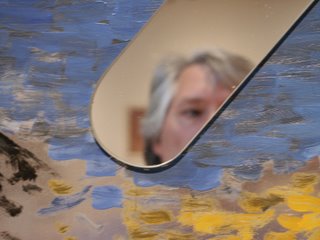 contemporary Hungarian art. His style is abstract and geometric shapes, creating an “Idol” (puppet) as the central theme of his work. I never learned to savor abstracts or geometric art, so most of this exhibit was wasted on me. The idea of the puppet was not explained further and seemed to be too metaphorically abstract for my thinking, so I let it go into the ethers for others to absorb. Ron has a degree in Philosophy and found much deeper meaning in many of the pieces than I ever would strive for. I did however, make it into one of his abstract paintings, a bit abstract myself.
contemporary Hungarian art. His style is abstract and geometric shapes, creating an “Idol” (puppet) as the central theme of his work. I never learned to savor abstracts or geometric art, so most of this exhibit was wasted on me. The idea of the puppet was not explained further and seemed to be too metaphorically abstract for my thinking, so I let it go into the ethers for others to absorb. Ron has a degree in Philosophy and found much deeper meaning in many of the pieces than I ever would strive for. I did however, make it into one of his abstract paintings, a bit abstract myself.
The handout also states that Diem’s last Budapest exhibit was in 1992, also at the Ernst. It does not clarify why this is. We did notice that many of the pieces, large and small, paintings and sculptures were marked “Artist’s private collection”. This raises the question of whether or not he found a market for his work. The few pieces which were ‘on loan’ from other museums, were from the Szentendre Museum. Even fewer were in the hands of private collectors. Pál, do you have a day job to pay your way? Inquiring minds want to know.
 Stop 2 was the Banknote and Coin Exhibition located on
Stop 2 was the Banknote and Coin Exhibition located on Szabadság tér 8, the same square that houses the US Embassy. We walked all around the square before we found number 8, but the building was closed, though the tour information states it is open every day. These photos are of a building around the corner that I have always loved and never had my camera handy when in that area. Alas, with the museum closed, we would just have to stop at the Farger’s café even earlier than expected. This café was not open either, a greater disappointment than the exhibition being closed. We went to the café in the middle of the square, which has surly servers in addition to overpriced drinks.
Szabadság tér 8, the same square that houses the US Embassy. We walked all around the square before we found number 8, but the building was closed, though the tour information states it is open every day. These photos are of a building around the corner that I have always loved and never had my camera handy when in that area. Alas, with the museum closed, we would just have to stop at the Farger’s café even earlier than expected. This café was not open either, a greater disappointment than the exhibition being closed. We went to the café in the middle of the square, which has surly servers in addition to overpriced drinks.
Ron needed to teach a private lesson, but since he still holds the title of Mr. Map, he was kind enough to accompany me to the Hungarian Natural History Museum. When we arrived at the square, the building looked old, worn down, and vacated. I was steadying myself for another strike out when we found the door was locked. The entrance was actually to the left in a new modern building. Once in the lobby, Ron took his leave and left me to my own wanderings. I was a bit horrified at the admission cover of 1,200 Huf. The ticket is lovely, but I could forgo this for a lesser price. This was one of the priciest museums and could be one of the reasons students did not show. Those over 65 do get in free with an ID.
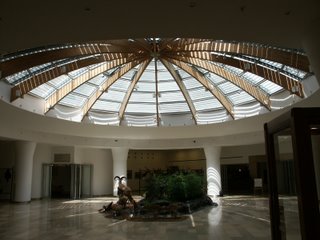 The building is new, clean, and modern. The first exhibit as you walk in was enough to send me flying out again. There were magnificent African animals stuffed and set around a pond. Other exhibits were more exquisite specimens, head and shoulders only, torsos missing. After seeing so many of these creatures alive in their natural environment in South Africa, it was devastating to see these specimans; the result of one man's need for sport killing.
The building is new, clean, and modern. The first exhibit as you walk in was enough to send me flying out again. There were magnificent African animals stuffed and set around a pond. Other exhibits were more exquisite specimens, head and shoulders only, torsos missing. After seeing so many of these creatures alive in their natural environment in South Africa, it was devastating to see these specimans; the result of one man's need for sport killing.
The saving grace was the sign designating the coral reef, which caught my eye. Through a large passageway, they have created coral reef displays on the floor and covered it with thick glass. The sense of walking on water did not escape me. In some areas, there are large aquariums filled with colorful and spectacular live coral and other sea life.
I was lucky to have happened here today as they temporary exhibit was “The Mummies of Vác”. It seems that people were buried in their highly decorated coffins and placed in a burial vault in a church in Vác. At some point in time, the door to the vault was sealed over and forgotten. When it was rediscovered the temperature and humidity made perfect conditions for the dead to be mummified. Thus, there were mummy, not complete skeletons in the coffins. This dates back to the late 1700s. Most of my 2 ½ hour visit to the museum was spent here.
conditions for the dead to be mummified. Thus, there were mummy, not complete skeletons in the coffins. This dates back to the late 1700s. Most of my 2 ½ hour visit to the museum was spent here.
The rest of the museum was modern, bright, colorful, clever, educational, and entertaining, but with a definite focus for children. If one were traveling with children, this would be necessary to visit. For adults alone, unless the exhibit is still there, I would say it is avoidable unless you have a fervent interest in seeing stuffed animals. I am not sorry I went, but I most likely will not return any time in the future either.
Typical of these parts, though, I bought a ticket from the cahier. There were two people waiting to help visitors at the coat check area. Hardly busy in 80+ degree weather, yet there were two of them. Then the guard at the main entrance looked at my ticket sticking out of my shirt pocket. When I went to the mummy exhibit, there were two more people sitting at opposite sides of the entrance. The young man asked for my ticket. I said I did not know if I had a special ticket for this exhibit and handed him my entrance ticket. He said I did as he snipped the corner off of my ticket. So the question in my mind is if everyone gets a ticket that allows them into the special exhibit, why are there two people manning the door? Then on the second floor, I did not see one employee, other than the young woman sleeping on a chair in the hallway, but on the third floor, there were six like a gaggle of geese chattering away. Some things will never make sense to me.
Posted by
Anonymous
at
5:23 PM
![]()
![]()
Labels: Abstract art, Arts and Entertainment, Coffeehouse, Metropolitan Museum of Art, museum, Museum Resources, painting
Saturday, July 15, 2006
Bastille Day Celebrations
0 commentsThe French Institute decided to have the Bastille Day celebrations a day late, since it fell on a Friday. Saturday was the designated day with the street fair and entertainment. We had intended to see what the French do that the Americans here do not do for 4th of July. We invited Angela, a former Fulbright scholar, who is here again studying Hungarian. She in turn invited a new friend from her classes.
With the red metro closed at some stations for the summer reconstruction project, we had to take a tram over the river and then a second tram toward the designated area. The tram, however, only went part of the way due to an additional celebration on the bridge. From there, we walked along the river, the air cooler than during the day, but refreshingly pleasant.
The French festivities went for blocks all riverside, so the cement wall along the river was a convenient place to sit once one had stood in line for food and drink. Avoiding this at first, we weaved in and out of the crowds, the length of the promenade, to see what the offerings were before making any decisions. It was a successful turnout judging from the hordes.
Angela and I had the same thought simultaneously she said when I expressed it; there was no French food, wine, or beer booths. Everything was Hungarian with one exception. The Belgium restaurant had a booth selling beer right outside of their establishment door. This was the disappointment of the evening. We were whetting our appetites for some French morsels, something different from the usual fare available, but it was not going to happen here.
There were two stages set up with music, but the singers were singing in Hungarian. Where was the French influence in any of this? It escaped at least three of us present. The closest we came to having a French experience was to go to the 24 hour palacsinta restaurant. Palacsinta is a Hungarian crepe. It looks like a French crepe; it tastes like a French crepe. For the evening, we pretended our meal was French and not Hungarian. For 890 Huf, we each had 2 savory crepes filled with 2 different meat fillings and 2 with different fruit fillings, and a glass of soda.
As we were eating, now at 10:30 at night, the fireworks started. We could see most from our outdoor seating. At first the fireworks were red, white, and blue, the colors of the French flag, but then green was added, the color in the Hungarian flag.
As we were eating, we were wondering how many people would have attended if there were no Hungarian food or drink available, but only French? The common consensus was few.
Posted by
Anonymous
at
6:04 PM
![]()
![]()
Labels: Bastille Day, food, French, French cuisine, Hungarian, Institut de France, United States, Wine
Saturday, July 08, 2006
Obuda Museums
0 comments Our friend Linda is here visiting with her teen niece, Dana. I waited for the next museum day to see if they wanted to visit any with me and gave a very short notice to students of my agenda.
Our friend Linda is here visiting with her teen niece, Dana. I waited for the next museum day to see if they wanted to visit any with me and gave a very short notice to students of my agenda.
The first of the day was the Vasarely Museum in District III at Szentlélek tér 6, Metro: HÉV Árpad Híd. It is open: 10am-6pm Mar 15-Oct 31, 10am-5pm Nov 1-Mar 14.
Born in Pécs, Hungary in 1906, Victor Vasarely first started his studies as a doctor, but quit after his second year. He studied art at the Podolini-Volkmann Academy in Budapest and then at Alexander Bortnyik’s Mühely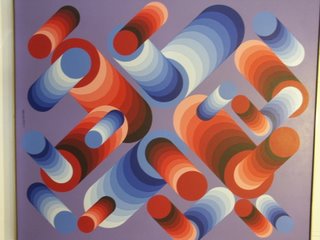 Academy also in Budapest, widely recognized as the centre of Bauhaus studies. He moved to Paris in 1930. Inspired by the Bauhaus movement of Walter Gropius in 1919, he found fame as an artist after exhibiting at the Boétie Street Gallery, Paris in 1944. Dubbed as the father of Op Art in the 60s, his familiar style of creating illusionary 3D geometric shapes on flat canvases has an almost hypnotic effect.
Academy also in Budapest, widely recognized as the centre of Bauhaus studies. He moved to Paris in 1930. Inspired by the Bauhaus movement of Walter Gropius in 1919, he found fame as an artist after exhibiting at the Boétie Street Gallery, Paris in 1944. Dubbed as the father of Op Art in the 60s, his familiar style of creating illusionary 3D geometric shapes on flat canvases has an almost hypnotic effect.
The museum is free entry, but if you want to take photos, the photo ticket is 300 Huf, a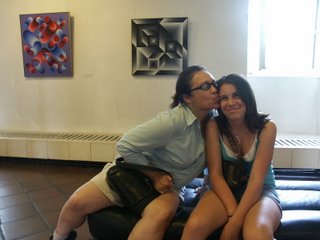 bargain for even one photo. The collection is situated in the two-storey wing of the old aristocratic home of the Zichy family. It consists of over four hundred pieces. Many of the pieces zapped me back to the op-art of the 1970s, which was a delightful walk down memory lane. As much as I did not appreciate Op-art then or now, it is was still captivating. I do recommend this museum. Keep your photo ticket visible and tap it when the ladies in attendance start to question if you have paid your dues to snap or they will snap at you.
bargain for even one photo. The collection is situated in the two-storey wing of the old aristocratic home of the Zichy family. It consists of over four hundred pieces. Many of the pieces zapped me back to the op-art of the 1970s, which was a delightful walk down memory lane. As much as I did not appreciate Op-art then or now, it is was still captivating. I do recommend this museum. Keep your photo ticket visible and tap it when the ladies in attendance start to question if you have paid your dues to snap or they will snap at you.
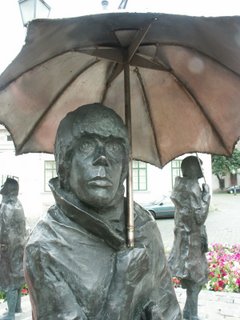 There were no students waiting for me so I went alone to the second museum. Linda and Dana went on to Szentendre.
There were no students waiting for me so I went alone to the second museum. Linda and Dana went on to Szentendre.
The next museum was Kun Zsigmond Folk Art Museum in District III at Fo" ter 4. It is only a stones throw from the first museum. One needs to look for the number, as there is a large brown door gate that leads to a courtyard. From there, the door to the museum is on the left where you ring the doorbell. They will buzz you in. As you climb the stairs to the first floor, you can start viewing the collection hanging on the walls.
This tiny museum is the private folk art collection of a man who lived to 107 years old. The collection boasts individual over 1,000 pieces. The entry was 300 Huf, but unfortunately, all I had was a 10,000 Huf note. Their cash box only held one 200 Huf note and a few coins, so I had to scrape together the entry from my change and skip the 500 Huf for the photo ticket. The woman who followed me around, whispered that I could take some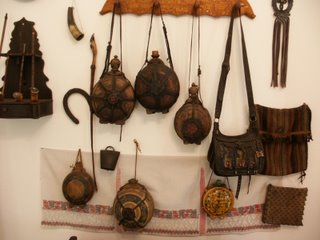 pictures if I wanted. I took a couple just to show my gratitude, yet not to abuse the privilege. As the booklet that they gave me states, the museum is not arranged as a regular museum, but rather as a home showing off the treasures. There were some intriguing pieces. Taking my time looking carefully, I was still finished within 35 minutes. The woman caretaker rushed ahead of me to turn lights on in a room before I reached it and then turned them out when I left.
pictures if I wanted. I took a couple just to show my gratitude, yet not to abuse the privilege. As the booklet that they gave me states, the museum is not arranged as a regular museum, but rather as a home showing off the treasures. There were some intriguing pieces. Taking my time looking carefully, I was still finished within 35 minutes. The woman caretaker rushed ahead of me to turn lights on in a room before I reached it and then turned them out when I left.
It was my intent to visit the Varga Imre Museum, again just a block away, but with only a 10,000 Huf bill, I knew they would not be able to cash it. The restaurants in the square were closed by this time, so there was not any convenient place to get it changed. Another day, another time.
Posted by
Anonymous
at
7:38 PM
![]()
![]()
Labels: Art Museums, Arts and Entertainment, Bauhaus, Budapest, Folk art, museum, Pécs, Walter Gropius
Friday, July 07, 2006
The Missing Book
0 commentsWhen I knew Ron was going back to the States, I started ordering books for him to bring back for me. Many of them were books I would use for teaching in the fall semester. Hunting for the best prices, I ordered from a variety of sources and then had them sent to his friend’s home in Iowa.
When he had left this friend’s home and was on his way to another friend who was hours away, I received an e-mail from her saying Ron had left one book behind. It was an essential book for a new course I would be offering in the upcoming term, so I had to have it. I suggested Ron turn back and get it, but it was not viable. The alternative was Postal Express via the USPS. She shipped it the next day, Monday. I insisted on paying the costs, knowing they would be beyond her budget regardless of her generous nature.
On the following Friday, the downstairs door buzzer starts ringing at 7:30 am. Having unsteady nerves with any buzzing, alarm, or beeping sounds since the burglar alarm incident, I jumped out of bed as Ron was asking "Who is that?" I keep telling him my psychic powers have dwindled with age, but he insists I should know these things. My initial thought was that we overbooked our rooms again. Oh, dear!!!
When I answered the intercom, a male voice said something not comprehensible, but it could have been the hour. When I asked again, I swore he said "Steve Turner". My mind raced, but I knew we were not expecting any Steve Turner. Finally, he said "Is THIS Ryan James?" Well if you can name me, I will let you in the building. Minutes passed as the elevator cranked up to the fourth floor and a short man in a postal uniform appeared at the door. "I need your passport, is how he opened the conversation. Forgetting I am now a resident with proper ID, I went for the passport, signed my name and received a package. My book arrived officially at 7:39 am.
$33.50 and "the check is in the mail", seriously!
Posted by
Anonymous
at
4:31 PM
![]()
![]()
Labels: books, government, Mail, shopping, Steve Turner, United States, United States Postal Service, US Postal Service
Sunday, July 02, 2006
Statue Park: Szoborpark
0 comments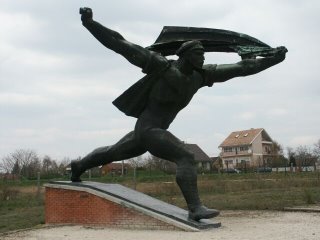 Statue Park (Szoborpark) is an open air museum that I have done in the past. As the expression goes, “Been there, done that”. Therefore, I have no desire to do it again even if personal guests begged me. It is located in the
Statue Park (Szoborpark) is an open air museum that I have done in the past. As the expression goes, “Been there, done that”. Therefore, I have no desire to do it again even if personal guests begged me. It is located in the
Back then, the statues represented, albeit superficially, a powerful symbol of Soviet strength and unity. Today, stuck out on the edge of town, they've lost much of their dignity, instead being brutally exposed as the idealistic follies that ordinary Hungarians always knew them to be. Worth a look, but not as impressive as most guidebooks would have you believe.”
For myself, some of the statues are impressive as pieces of art, but as the emotional symbols they are meant to infuse, the feelings are long gone. The park is a large fort like area that reminds me of the old Wild West towns in the US used to ‘recreate’ the feelings of the wild frontier.
When you enter and the cheesy Soviet music starts, you are consumed with a creepy feeling. The inside of the park is a stark rectangle with the statues running along the perimeter of the fence. Other than the wording on the individual statues if there is any, there is nothing to read in any language, no description of the statues, its purpose, or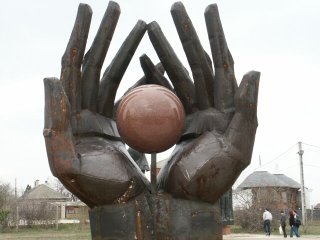 history. At the time we went, which admittedly was four years ago, it took us a strained 45 minutes to look at the statues, take pictures, and take pictures yet again to waste time until the bus returning to the city would be available to pick us up yet again.
history. At the time we went, which admittedly was four years ago, it took us a strained 45 minutes to look at the statues, take pictures, and take pictures yet again to waste time until the bus returning to the city would be available to pick us up yet again.
This is one site we never recommend to visitors unless they are staying in Budapest for more than seven days and have done everything else including counting the number of times a pooper-scooper could have been used on the streets within each district. No stars for this one.
Posted by
Anonymous
at
4:11 PM
![]()
![]()
Labels: Budapest, history, Hungarian people, Hungary, Living History and Open Air, Museums, Open air museum, Soviet Union
![Reblog this post [with Zemanta]](http://img.zemanta.com/reblog_e.png?x-id=e8d28ab5-a1d6-49b4-aa70-14c49e087e24)
![Reblog this post [with Zemanta]](http://img.zemanta.com/reblog_e.png?x-id=615e12d0-4de8-487c-b7c2-bd94dc93d49a)
![Reblog this post [with Zemanta]](http://img.zemanta.com/reblog_e.png?x-id=7c75de95-5158-4754-8ae2-1e6d84838794)
![Reblog this post [with Zemanta]](http://img.zemanta.com/reblog_e.png?x-id=2841beb8-5a72-48e7-9dc8-69946f19a201)
![Reblog this post [with Zemanta]](http://img.zemanta.com/reblog_e.png?x-id=28e3d641-5aa9-46f8-a51d-5943c2d924ef)
![Reblog this post [with Zemanta]](http://img.zemanta.com/reblog_e.png?x-id=316e2d20-7024-4f80-882f-e02c38dc8985)
![Reblog this post [with Zemanta]](http://img.zemanta.com/reblog_e.png?x-id=d56d4585-5603-4be8-9c78-033c7aa7b138)














